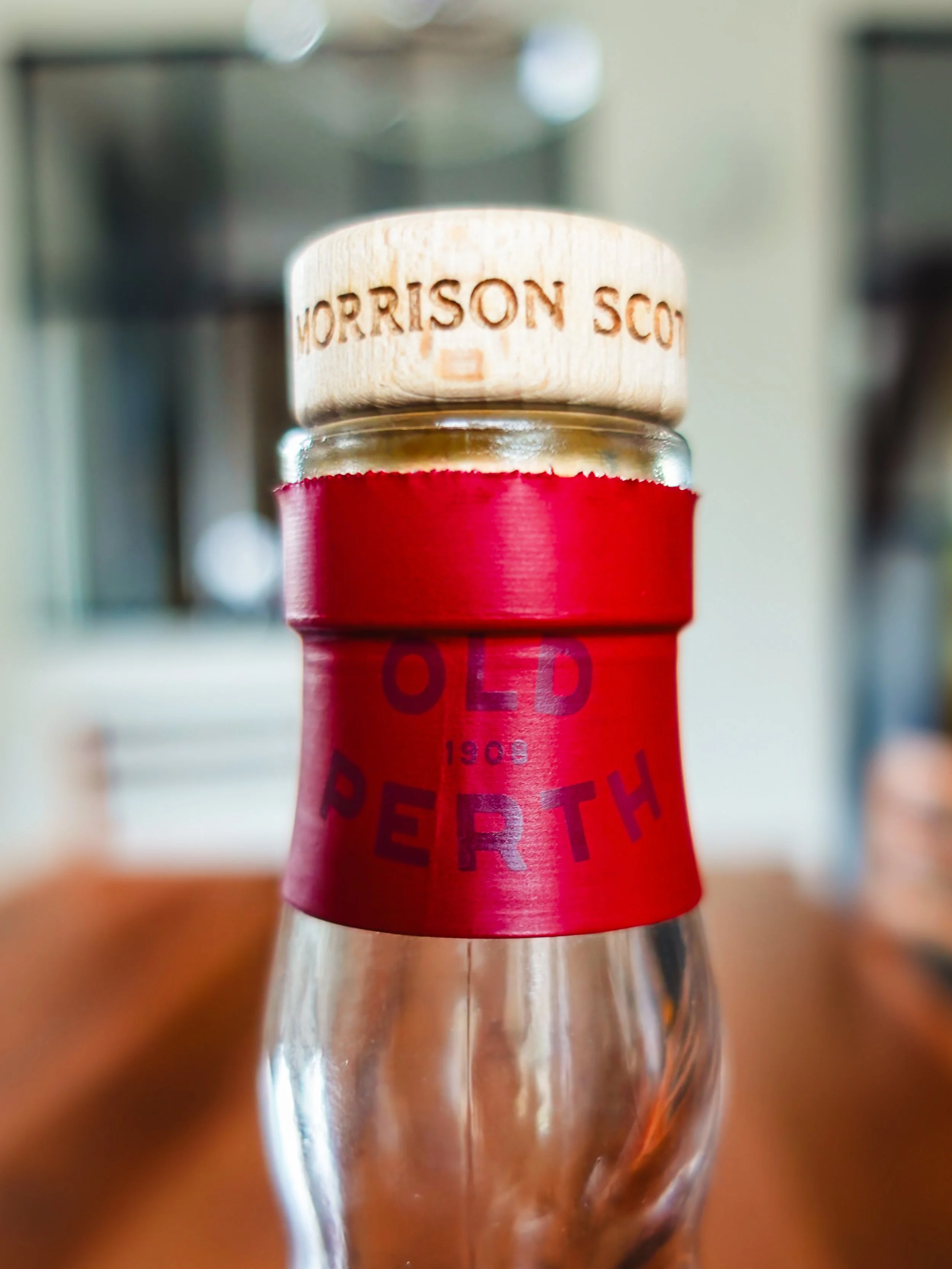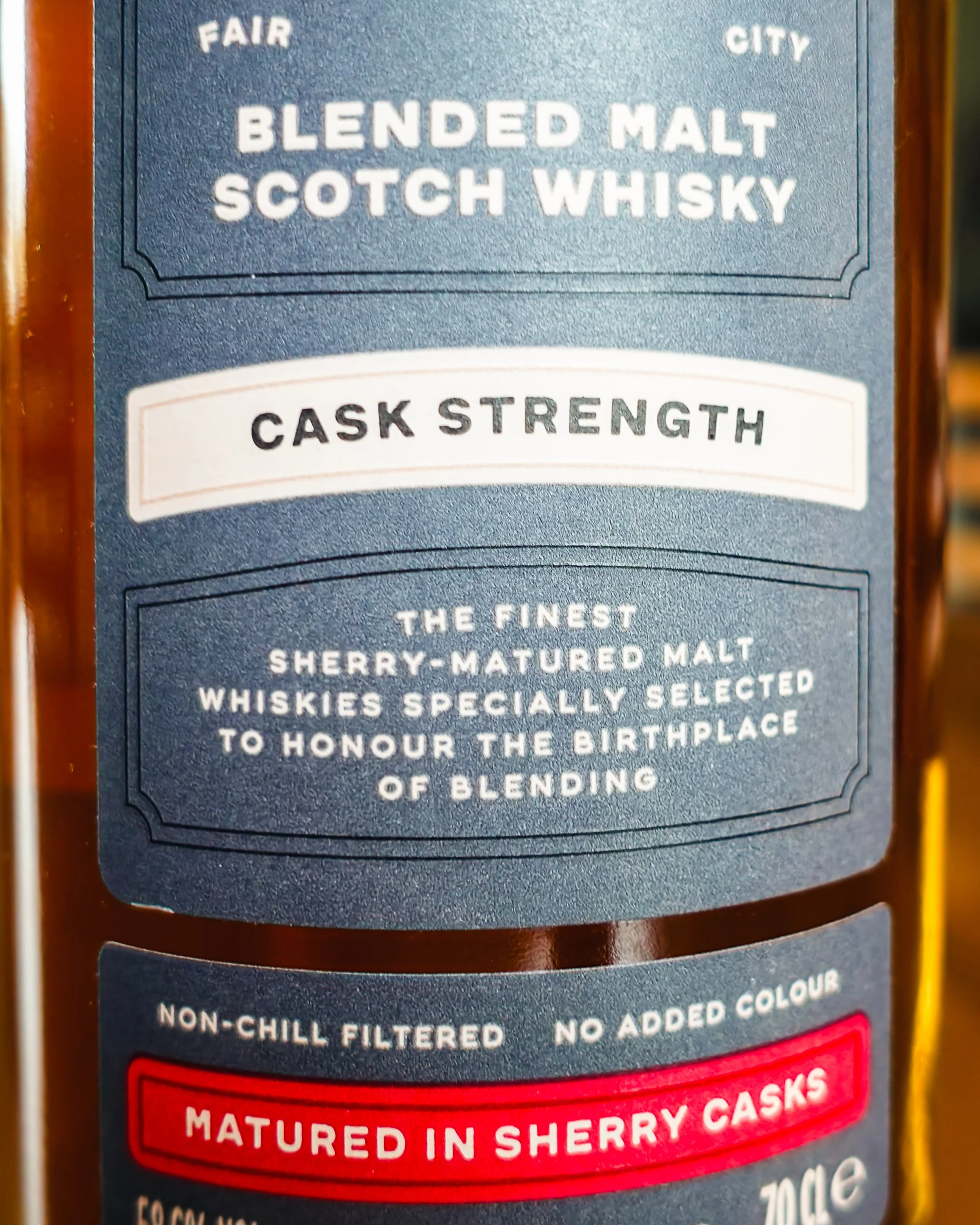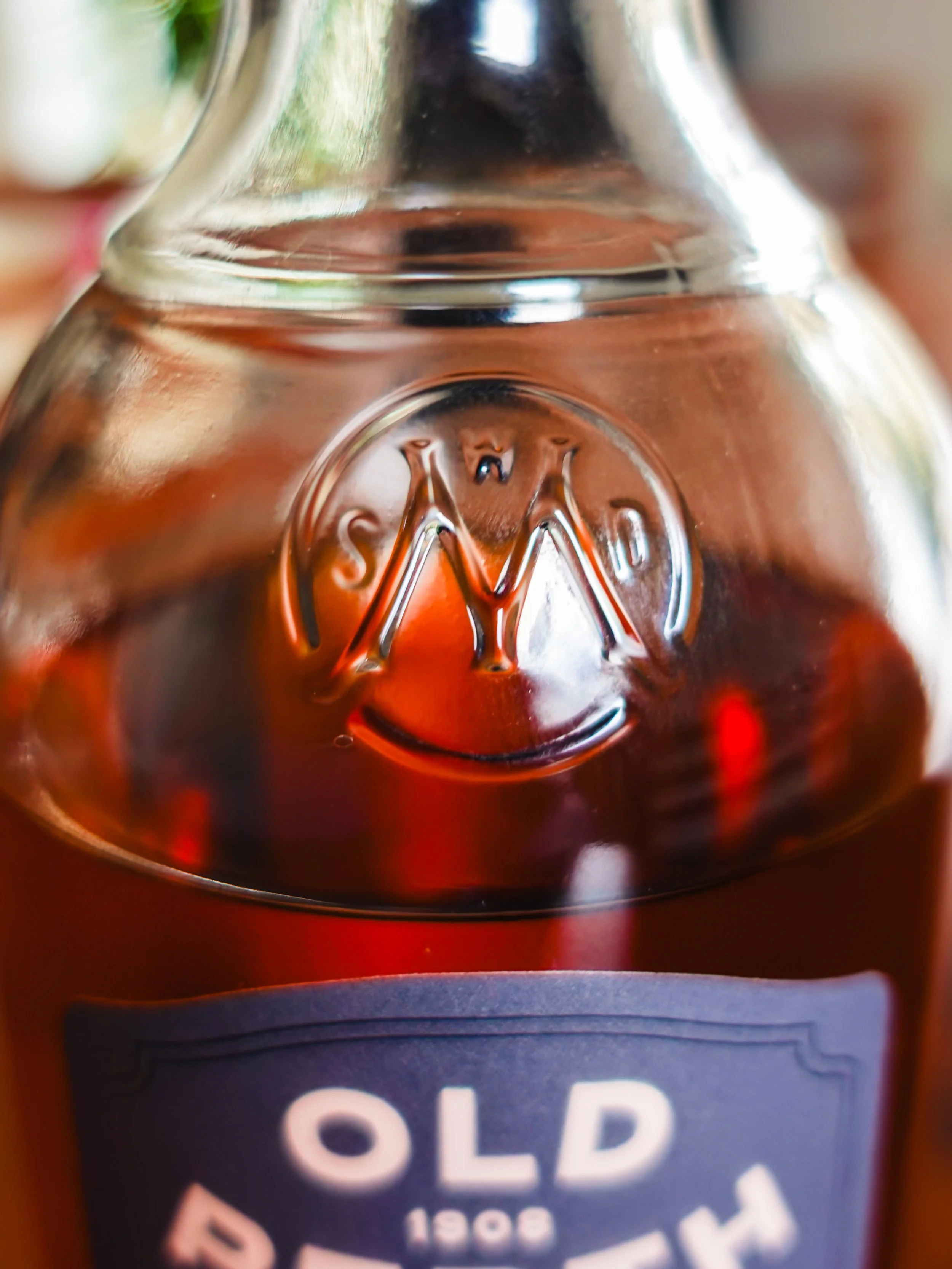Old Perth Cask Strength
Cask Strength Blended Malt - Sherry Cask
58.6% ABV
Score: 6/10
Good stuff.
TL;DR
Worthy of a space in the ‘daily sipper’ line up
The B-word
I’d love to pretend I am becoming an even-keeled, unbiased drinker; free from the influence of labels. Instead, I have to admit I am a sucker to my subconscious.
The more I embrace whisky with a passion, the more certain cues affect my mood, even before I crack open a bottle. Seeing the bell tower of Lorne Parish Church on a Kilkerran label immediately raises my expectations for the liquid inside the bottle. Likewise, when I see the name Thompson Bros. on an independent bottling, I immediately feel I am about to have a treat of a dram… talk about Pavlovian conditioning.
I am not terribly surprised by this realisation; bias exists for a reason. It is our brain steering us towards something it thinks is good for us. Or, in the case of whisky and based on previous experience, something which is likely to engage our taste buds in a positive fashion. Which is definitely the case for my two examples above. For someone relatively new to this whisky thing, who has used twelve of the most recent months to explore well beyond the recognised and appreciated core lineup of Dramface’s Top 20 or so distilleries, maybe it is also a sort of safety blanket.
The recognition of my own bias, and an unexpected comment which I’ll get to in a moment, got me thinking (it happens, occasionally) about broader biases around whisky, especially around the contraposition between certain categories of whisky. Is my drinking affected by an underlying bias of splitting Blends from Single Malt? And while we are at it, what about the Blended Malt category? Is it, first and foremost, something I see as Malt or Blend? A few reviews back, Wally was arguing that we are getting past that way of thinking. Maybe, as whisky botherers, we are. And yet, I can’t help wondering how casual drinkers perceive that name.
The romantic in me wants to quote Shakespeare’s Romeo and Juliet quote: “That which we call a rose by any other name would smell as sweet”. After all, good whisky is good whisky. But life has made me a bit of a cynic. A good-natured one, but a cynic nonetheless. So I lean toward adding the quip (wrongly attributed to Mark Twain): “…but would not sell as well.”
Names matter. Would Pepsi have thrived as “Brad’s Drink”? Would Google have succeeded as “BackRub”? As fun as it is to imagine BackRubbing as a term for online searches rather than potential sexual harassment, I doubt either would have stuck.
Clumsy brand names aside, certain words carry baggage that affect our perception of quality. Would you prefer to eat a mudbug or a crayfish? A dolphinfish or a mahi-mahi? Even though the names in both examples refer to the exact same thing, I’d rather skip the bug and the dolphin please, and thank you.
Let me get to what triggered these though: a brief whisky-related interaction I had a couple of weeks ago.
I have been trying to build a small circle of whisky-curious folks closer to home. I love our online community, but I feel compelled to share some whisky evangelism in real life and in my native Italian. That’s how I discovered a work friend who, while not an enthusiast, is a long-standing fan of single malts. My colleague is somewhat older than me and fell in love with whisky at the tail end of Italy’s golden era of whisky, the one so aptly described by Earie in his Samaroli review. This left him with a loyalty to single malts he discovered back in the late 80s and early 90s, especially some of Diageo’s Classic Malts, Laphroaig, and the occasional Macallan.
I have been trying to introduce him to some of today’s whisky enthusiasts’ favourites. So, when he asked me if I had any suggestions for a fairly priced whisky bottle for informal drinking, your everyday sipper if you wish, I first listed some of the obvious integrity bottled entry-level single malts like Arran 10, Ledaig 10, and Bunnahabhain 12. Then I decided to take a bit of a gamble: I pointed him to some blended malts, which are among my favourite whiskies for value right now.
That did not get the reaction I was hoping for. Something was uttered with disdain along the lines of “Blends are OK for the supermarket”. I think my friend was slightly offended.
How could I, knowing he was asking for a “proper whisky”, suggest a blend? I decided to leave the fight on blended Scotch for another day. But more on that at the end. After I explained the difference between Blended Scotch and Blended Malt, he softened—but his parting remark stuck with me: “Why would you call two things that are so different with such a similar name? That’s a stupid marketing choice.”
That one comment stuck in my head and triggered the idea behind this review. As whisky geeks, we take certain things for granted, like the difference between blended scotch and blended malt. But possibly, to the casual drinker, “Blended Malt” is more likely to recall mass-market blends than single malts, even though it represents something entirely different. Maybe it’s the “mudbug” of the whisky world—technically accurate but unappealing.
As a “Continental”, I see blended malt is a perfect example of British matter-of-fact attitude. The name explains exactly what the liquid in your bottle is. But it is also neither fish nor fowl - neither single malt nor blended scotch. I suspect that if blended malts were an Italian or French product, they would proudly call out to us, exalting the craft of the distiller (real or hyped) from their labels with names like “Selezione d’eccellenza” or “Assemblage Exceptionelle”. Cool-sounding names with vague meanings, for sure. But don’t they sound much more exciting?
Review
Old Perth Blended Malt, NAS release, ‘matured in Sherry Casks’, 58.6% ABV
€39.90 paid (£33.50) on offer and widely available around £50
I need to go back to Wally’s question. Have I really put my prejudice regarding blended malt behind me? As much as my friend’s reaction to the “blend” label had taken me slightly aback, looking at my own whisky-buying choices, I realise it may not be that different. I may have more of an open mind towards Blends, both Scotch and Malt, but looking at my collection, you wouldn’t know. About one in twenty of the bottles on my shelves fall in the broader blend category. Talk about the pot calling the kettle black.
I have been lying to myself. It seems my subconscious approach is that blends are fine, but single malt is inherently more purchase-worthy. But, as those who know me sooner or later find out, I hate set opinions that never get challenged. More than anything, when that opinion is my own.
And so, as a bit of a self-challenge, and inspired by the interaction with my work friend, I set off to compile my ideal “daily drinker” blended malt lineup. One which would cover the basis of the four main flavour profiles: Ex-Bourbon, Ex-Sherry, Peat and Funk. (And if you are wondering why only blended malts and not blended scotch, it’s because I am making up the rules of my own silly little game, alright?)
Most of the picks for the list were easy.
Choosing Campbeltown Loch for funk is an almost embarrassingly obvious choice. Even the “less than stellar” batches are a pleasure to sip. The ex-bourbon slot in the lineup forced me to pick between two favourites. In the end, Compass Box Orchard House lost by a mere smidge to the Thompson Bros SRV5. There is an emotional reason for that: SRV5 always transports me to a cosy and mild early autumn day spent lazing about. And I cannot argue with that. The peated Blended Malt offered plenty of solid choices, but I have a soft spot for the balance of ex-sherry and ex-bourbon cask influences in Elixir’s Elements of Islay Cask Edit, another easy pick.
The one category I struggled to find a satisfying blend for was the ex-sherry one. I wanted a blended malt, which would stand up to the other three bottles I picked. I tried a few different Sherry-forward blended malts, based on my limited local availability (not great to be honest). While most of the ones I tried were perfectly fine, to my taste they were too polished, too edgeless. Fruity, sugary and rich with sweet spice but lacking some much-needed contrast, be it a meaty, saline or even a well-integrated sulphur-driven note.
This might be very personal, but I find that if ex-sherry cask influence is not counterbalanced by some contrasting note, it becomes too much of a good thing. A bit like cake baked with or without a pinch of salt; that little saltiness makes the flavours shine so much more. So, I turned to the ever-generous online whisky folks. And thankfully, this community’s buzz is a great compass of what to seek out. I kept hearing good things about Old Perth, a line of blended malts I had overlooked. So when an offer for the Cask Strength appeared in one of my regular online retailers, I decided to pull the trigger.
Score: 6/10
Good stuff.
TL;DR
Worthy of a space in the ‘daily sipper’ line up
Nose
While no one would ever take this for anything but a sherry-cask aged whisky, even blind, this is not a sherry bomb. For something bottled at cask strength, the cask influence is assertive but not overwhelming. I smell buttery toffee, raisins, dry cherries, baked apples, and pears. The spices, a lot of nutmeg, with a bit of clove and cinnamon, are clearly noticeable - but not aggressive. It is as if someone had mixed the classical spicy and fruity Christmas pudding with the more buttery and caramel-rich Scottish Ecclefechan tart. And when it is about to become too sweet, there is a meaty stock cube note and a touch of citrus freshness to provide some much-needed contrast.
A small teaspoon or two of water amps up the intensity of the sweet and spicy aromas and adds a pleasant nutty edge. I get some additional notes of heather honey, milk chocolate, and figs. The one thing that suffers from the dilution is the meaty note that I noticed in the neat liquid, which almost disappears, leaving me looking for something to cut across the sweet and spicy notes.
Palate
The mouthfeel is quite rich and a little hot. Not that surprising at close to 59% ABV. As with many NAS whiskies, we are not given to know how old the liquid in this Old Perth Cask Strength is, but we can safely assume that most, if not all, of the blend components are below 10 years of age. Not to the point of drinking ‘unripe’, but there is a certain youthfulness. Overall, the flavours are rich, with a noticeable malt note coming through as a big hit of creamy Ovaltine. Then, I taste a buffet of sherry-driven notes. Brighter at first with baked apples, milk chocolate, ginger, and cinnamon. Then going towards darker and more toasted notes of treacle, orange peel, hazelnut, and a bit of mocha. And there again, right at the end, is a touch of umami, this time with a little bitterness, to lend a little zing to it all.
The finish is medium to long. It is closer to the notes on the nose. Rich with fudge and dried fruit (raisins, currants, cherries), then spicy with ginger and cinnamon. The aftertaste lingers on an orange oil note and a slightly drying, woody mouthfeel.
With water, the taste changes to a more spicy version of itself, but the main malt and sherry-driven notes remain consistent. The one thing that is tamed is the slight youthful exuberance.
The Dregs
This is a solid, good take on a sherried Speysider. The sweet and fruity aromas make me think of a light “clean” spirit aged in American Oak casks. That, in itself, would make for a pleasant sipper, maybe suffering from being too clean, not unlike other Sherry-forwards Blended Malts I tried before. Luckily (for me, your mileage may vary), there is that little touch of meatiness and bitterness which creates just enough contrast to keep things engaging and the vote above average.
Sure, if I were looking for something to critique, I could point out that there is a bit of a youthful edge; but it’s not excessive and a few drops of water make it even less noticeable. On the other hand, if you look at bang for your buck, this is up there. Even more so if you can grab one on offer like I did.
I am not letting price affect the score, but if that is something you factor in how you frame your scores, this might easily be bumped to a 7. After all, how many solid, non-chill filtered, nor caramel coloured, cask strength Speyside Malts can you find around this price?
Did I find the missing piece for my blended malt lineup?
Maybe. I wouldn’t normally choose a cask strength bottle for that, but why not - after all it gives me an excuse to play around with using water to find my ideal dilution point. And, as a heavy-handed klutz, it is a skill I need to get better at.
Before I leave you, let me offer a bookend to my whisky evangelism attempt. I am now on a mission to convince my friend that blended scotch is not just something cheap for the supermarket. I started by gifting him a bottle of Adelphi’s MacLean’s Nose.
Let’s see how that goes.
Score: 7/10
Tried this? Share your thoughts in the comments below. HC
-
Dramface is free.
Its fierce independence and community-focused content is funded by that same community. We don’t do ads, sponsorships or paid-for content. If you like what we do you can support us by becoming a Dramface member for the price of a magazine.
However, if you’ve found a particular article valuable, you also have the option to make a direct donation to the writer, here: buy me a dram - you’d make their day. Thank you.
For more on Dramface and our funding read our about page here.
Other opinions on this:
Got a link to a reliable review? Tell us.



































